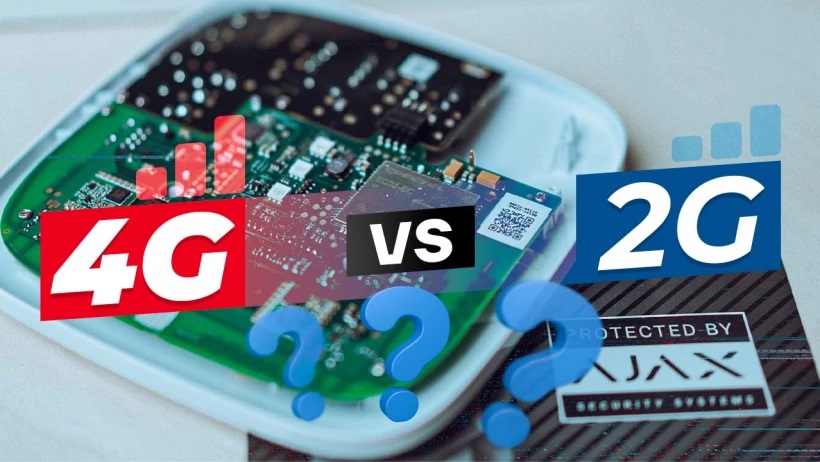
Jak často jste přemýšleli o tom, jak velký je rozdíl mezi jednotlivými generacemi mobilního internetu - 2G, 3G, 4G? Nezkušenému laikovi se může zdát, že rozdíl je minimální, ale zdaleka tomu tak není
Známá společnost Ajax, která se zabývá segmentem zabezpečovacích systémů, nedávno vydala novou verzi svého zařízení Hub 2 s modemem, který podporuje nejen 2G, ale i 3G, 4G mobilní internet. Co to vlastně znamená a proč rozbočovač potřebuje nový modem? O tom si povíme více v našem článku.
Ajax Hub 2 (4G) - funkce
Je nový modem Hub 2 (4G) od výrobce zabezpečovacích systémů Ajax tak dobrý? Jaké jsou hlavní funkce a výhody tohoto modelu, pokud jej porovnáte například s předchozí verzí Ajax Hub 2, která má GSM modem pracující s 2G internetem?
Co je to rozbočovač? Je to jakýsi "rozbočovač" zabezpečovacího systému, ke kterému jsou již připojena ostatní zařízení. Rozbočovač Ajax tak komunikuje s řídicími senzory, akčními členy, opakovači a dalšími zařízeními.
Je to centrum, které uchovává informace o místnostech, skupinách, přidaných zařízeních a vytvořených scénářích. Rozbočovač zároveň neustále komunikuje se serverem Ajax Cloud - díky tomu je možné zobrazovat aktuální informace o stavu systému například v mobilní aplikaci nainstalované na chytrém telefonu.
Umožňuje také generování oznámení push. Hub může majiteli zavolat nebo poslat textovou zprávu. Za to je zodpovědný také modul gsm, který je nainstalován v rozbočovači. Co byste tedy měli vědět o nábojích od výrobce Ajax?
Především mají tato zařízení několik komunikačních kanálů, včetně:
- Ethernet;
- Wi-Fi (u některých modelů);
- Modul GSM.
Ačkoli je kanál Ethernetu považován za prioritní, většina rozbočovačů má nainstalovanou kartu SIM. Připojení k internetu prostřednictvím karty SIM slouží jako záložní komunikační kanál. Existují také situace, kdy je mobilní internet jedinou dostupnou možností připojení.
V takových chvílích je třeba zvážit, jaký modul GSM je v rozbočovači nainstalován. Ajax Hub 2 (4G) a Ajax Hub 2 (2G) se liší svým gsm modulem, a tedy i schopností pracovat s různými generacemi mobilního internetu.
Hlavní rozdíly
Co tyto nuance znamenají v praxi? Jaké jsou výhody sítí 4G? Jak bylo uvedeno výše, 2G, 3G a 4G jsou různé "generace" mobilního internetu. Před nimi existovaly generace 0G a 1G, které se používaly výhradně pro hlasové hovory.
S každou další generací mobilního internetu se zvyšovala i rychlost přenosu dat. Například v sítích 2G je rychlost přenosu dat přibližně 50 kilobitů za sekundu, v sítích 3G se zvýšila na 2 megabity za sekundu a v sítích 4G dosahuje úctyhodných 100 megabitů za sekundu.
Při sledování streamovaného videa ve vysokém rozlišení a s vysokou snímkovou frekvencí na chytrém telefonu je jistě vhodnější volbou nejnovější generace sítí 4G. Je však taková rychlost u nábojů skutečně nutná? Potřebuje ji bezpečnostní alarm?
Množství dat, které rozbočovač přenáší, je ve skutečnosti tak malé, že mu stačí i 2G internet. To se mírně změnilo s příchodem senzorů Ajax, které podporují fotografické ověřování alarmů. Díky připojení s vyšší rychlostí přenosu dat mohou být fotografie doručeny rychleji, pokud je takový snímač spuštěn.
Samotná aplikace bude také výrazně "rychlejší", což není nepodstatné. Hlavním důvodem, proč používat modem 3g a 4g, je prostý fakt, že v mnoha zemích podpora sítí 2g téměř zmizela.
To znamená, že rozbočovač nelze s takovým modemem fyzicky používat. Je důležité si uvědomit, že z hlediska rychlosti přenosu dat má rozbočovač dostatečnou kapacitu modemu 2G. Je však třeba vzít v úvahu i další faktory ovlivňující výkon zařízení - například snížení pingu nebo zpoždění paketů.
Standard 4g zvyšuje "kapacitu" sítě o řád ve srovnání s 2G. To v důsledku znamená, že ani v místech s velkým počtem současných připojení k síti operátora rozbočovač "neztratí" spojení a samotné spojení zůstane stabilní.
Jinak je to stejné jako rozbočovač s modemem 2g:
- Až 100 připojených zařízení;
- Až 50 uživatelů;
- Možnost vytvoření až 9 skupin pro rozdělení čidel do jednotlivých zón.
Tato funkce vám umožní pohodlněji spravovat a ovládat všechna zařízení.
Tento rozbočovač navíc umožňuje připojit až 5 opakovačů signálu ReX. Umožňuje také vytvořit až 32 scénářů a podporuje snímače pro záznam fotografií.
Závěrem
Vyplatí se tedy zvolit rozbočovač s novějším modemem GSM, nebo je koupě "starší" verze dobrý nápad? Pokud hledáte pouze spolehlivý poplašný systém, zejména pokud plánujete používat snímače se záznamem fotografií, je Ajax Hub 2 (4G) jasnou volbou.
Toto zařízení je speciálně navrženo tak, aby využívalo všechny možnosti vysokorychlostního přenosu dat dnešní generace mobilního internetu. Na druhou stranu, pokud je k dispozici stabilní pokrytí operátora a spolehlivé připojení, je Ajax Hub 2 (2G) zcela dostačující pro plný provoz rozbočovače.
